Contents
Potatoes are the most common product grown in the garden or cottage. Potato planting technology is different. It all depends on the knowledge of the gardener and the tools he has. This article will look at the best technologies used today for planting potatoes.
Distinctive features of Dutch technology
Recently, planting potatoes using Dutch technology has become increasingly popular. This method of landing in our country is considered relatively new. Some gardeners sometimes use certain elements of Dutch technology.
The basis of the Dutch technology of planting potatoes is a whole complex of various agricultural practices. It includes:
- tillage of a plot of soil with the help of special milling tools. As a result, the soil becomes looser;
- mandatory spraying of plants with various drugs against late blight. This disease can destroy an entire plantation in just four days;
- tillage with herbicides. If you omit this item, then it is necessary to carry out periodic weeding of the weeds that have appeared between the ridges. To do this, you can use a traditional hoe or chopper. But weeding should be done very carefully so as not to damage the root system of plants and not to displace the stems that have already taken root;
- formation of high-volume ridges. Their formation occurs as a result of the passage between the rows of a special unit. It is done once – at the beginning of the landing.
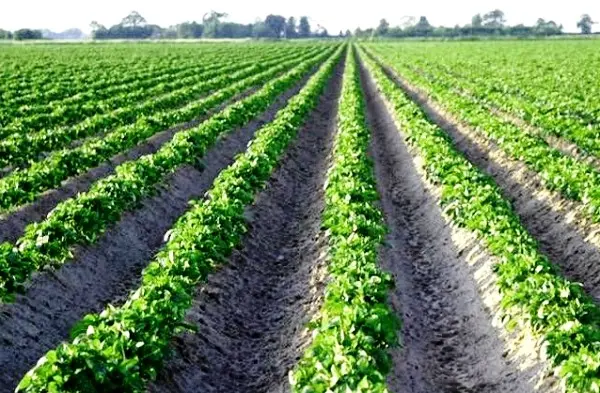
A distinctive feature of this technology is to minimize the number of mechanical treatments required in the process of caring for the plantation. In addition, the following points can be attributed to the distinctive features of this technology:
- to place potatoes, a plot with a high agrobackground is used;
- a prerequisite is the alternation of cultures. Return to the original landing site occurs only after three or four years;
- mandatory cleaning of the soil from all kinds of pathogens, pathogens, bacteria and fungi before crop rotation;
- use only high-quality planting material. This point is very important for Dutch technology. Our gardeners need to strictly adhere to this paragraph if they want to get a really good harvest. In Holland, only high-quality planting material is always planted, and therefore their harvest is always excellent (unlike our compatriots). According to technology, tubers should be 30-50 mm in diameter. Only tubers with varietal purity and high reproduction are used (elite and super-elite varieties);

- preplant tillage in order to increase the yield of future seedlings;
- heating or germination of tubers. Shallow landing to a depth of 4 cm is possible;
- when the first shoots appear, it is necessary to form ridges, the height of which is about 25 cm, and the width is 75 cm.
Our gardeners are more economical use of the land, so often the distance between two adjacent ridges is only 45 cm. As a result, manual hilling requires more care.
When using the Dutch technology, much attention is paid to the calculation of the planting density of potatoes. Seed material is obtained by dense planting, in which there are at least 30 bushes per square meter. For further planting, only those tubers that have five or more eyes are selected. Further, the planting map involves planting six tubers per square meter.
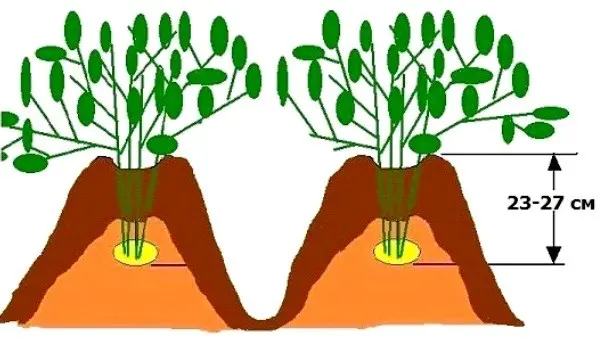
The scheme of hilling potatoes on the ridges
In addition to the above features, the technological process of the Dutch planting and growing method involves the creation of optimal conditions for the rapid development and growth of potato bushes. To do this, tubers are harvested relatively early, which prevents infection with various diseases, especially late blight. All tops are removed from the field. The tubers are left in the ground for two weeks for their best ripening. As a result, a strong peel is formed on them, which prevents the possibility of any mechanical damage, and also increases the shelf life.
Traditional manual
The most common method of planting potatoes in our country is the traditional method – manual. This is due to the fact that everything new must first be tested, and the result will not always meet the gardener’s expectations. And the old proven method is good because it has been tested by many years of practice.
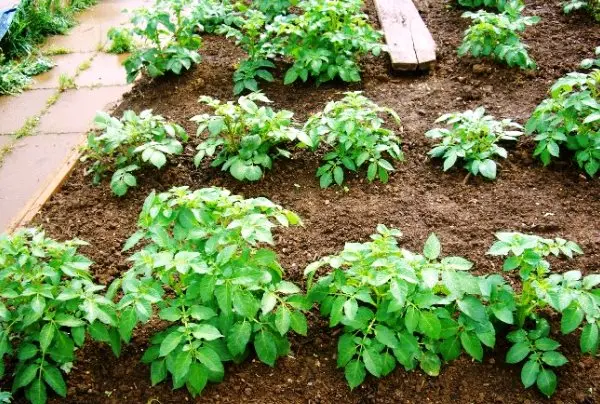
Manual traditional landing is carried out by three main methods:
- smooth landing;
- ridge formation;
- trench formation.
The choice of method depends on the characteristics of the soil in the summer cottage or garden. For example, in the case of loose, sandy and sandy soils, the trench method should be used. For loamy soils, the option with the formation of ridges is more suitable. Let’s consider each method in more detail.
Smooth landing, or “under the shovel”. A very simple method. Here you just need to lift a layer of soil with a shovel, put a tuber in the resulting hole and cover it from above. After planting, the ground should be leveled with a rake. This will reduce moisture loss.
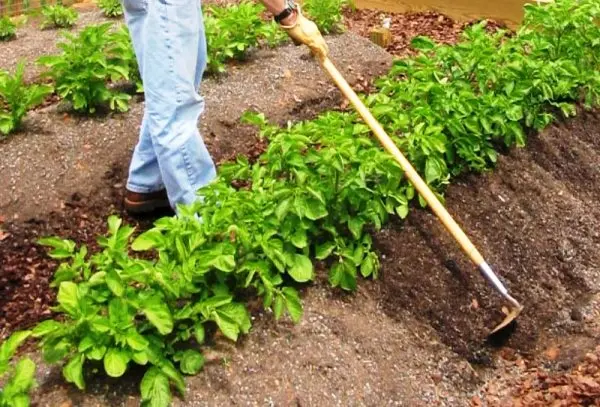
The disadvantage of this method is that it is very difficult to do the necessary actions alone. This requires at least two people. One must dig the ground, forming holes, and the second should follow and place tubers in the holes. In addition to potatoes, compost, fertilizers (urea, saltpeter) or humus should be put in the hole. When digging the next hole, the previous hole is covered with earth. It is often used in the presence of flat terrain on which water does not stagnate and the sun warms the soil well. In all other cases, you should not use a similar landing option.
Ridge formation. It is used at a high level of groundwater approach, as well as on waterlogged or heavy soils. This method involves the following manipulations:
- so that the ridges are even, you must first outline the furrows. Can also be used to mark the cord;
- with the help of a hoe or chopper form ridges. Their height is approximately 15 cm. The distance between adjacent ridges is 70 cm (a distance of 50 cm is also allowed);
- tubers are planted in these ridges. The ridges protect the tubers from possible soaking.
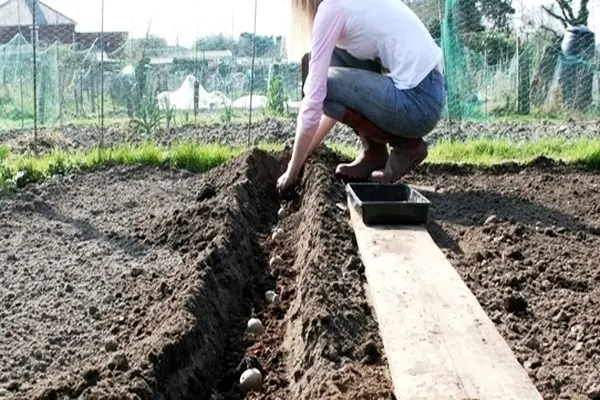
With moisture-intensive soils, this approach is justified. But if the soil is very light or loose, then ridge formation will be ineffective. The ridges will simply crumble during heavy rains, thereby exposing buried tubers. And if the summer turned out to be hot, then watering should be organized periodically to prevent the soil from drying out.
Formation of trenches. This method is most justified for sandy or sandy soils, as well as in the presence of a hot climate. At its core, this method is the opposite of combs. Here the landing deepens, not rises. As a result, planted tubers are protected from possible drying and overheating. It is not recommended to use this method on wet soils, as stagnant water and poor air exchange of the tubers will result in a poor harvest.
Whichever of the traditional methods is chosen for planting potatoes, they all require a minimum of effort. At the same time, their yield is almost the same. So the choice should be made only on the basis of soil properties and the availability of the required equipment.

Video “A simple and quick way to plant potatoes”
The video shows a manual method of planting potatoes without digging; the gardener shows how he plants the tubers in the furrows along the cord.
With the help of a walk-behind tractor or a planter
Another method of planting tubers is the method in which a planter or walk-behind tractor is used. This method involves the use of technology, which makes it possible to simplify and mechanize the process. Most often, a walk-behind tractor is used from the available garden equipment, as well as a special planter (used much more often).
A special country planter is very often used when planting potatoes using the Mittlider method. This method involves carefully cutting holes with a planter at the same distance along the narrow beds. The land after landing is leveled with a rake.
Using a walk-behind tractor, potatoes are planted as follows:
- Initially, even grooves should be cut. The whole process is accompanied by deep loosening of the soil. The distance between the furrows should be about 55 cm. This distance is left for convenience during further weeding;
- tubers that have sprouted well are placed in the furrows with the sprouts up. The distance between them is about 40 cm. With shallow planting material, the distance is reduced;
- furrows are covered with a motor cultivator or manually using a rake.
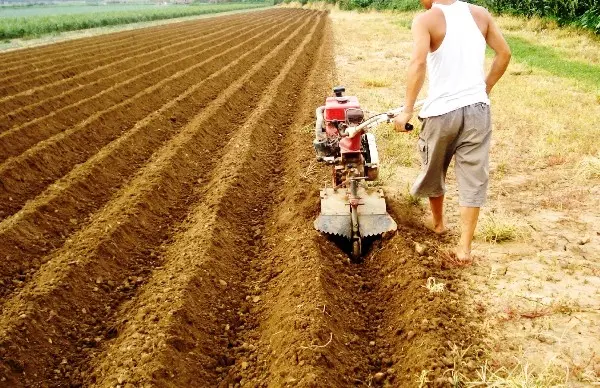
This method has many supporters, as it is characterized by the highest yield due to good loosening of the soil.
When choosing a method of planting potatoes, they proceed to a greater extent from the type of soil, as well as from the availability of specialized equipment at their disposal. If everything is done correctly and all the nuances are taken into account, then a high-quality crop can be achieved.
Video “Planting potatoes using a walk-behind tractor”
The video demonstrates the process of planting potatoes using a walk-behind tractor.










